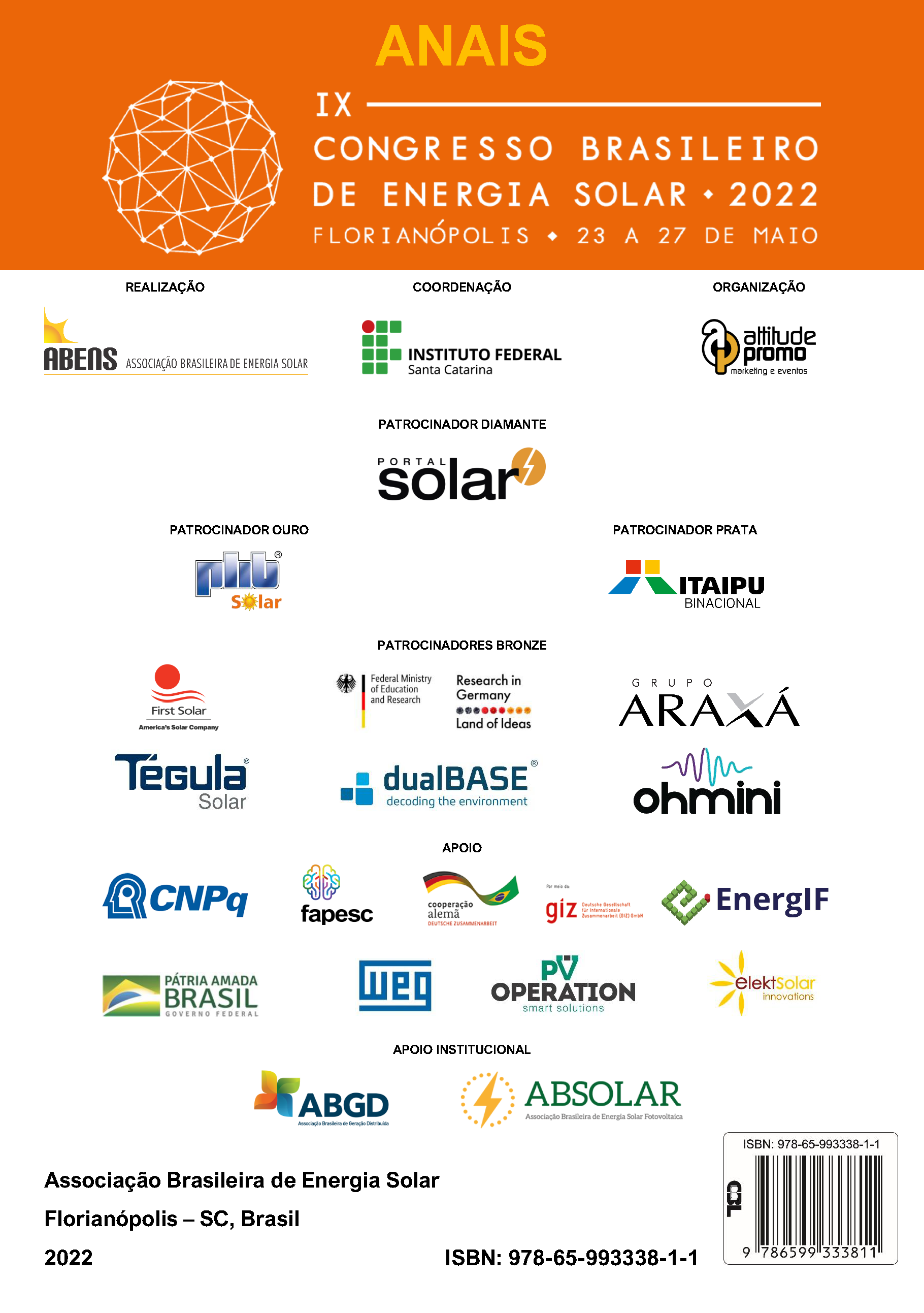ANALYSIS OF MERIT INDEXES OF FLOATING PHOTOVOLTAIC SYSTEMS IN DIFFERENT ENVIRONMENTS
SOIL AND FLOATING
DOI:
https://doi.org/10.59627/cbens.2022.1225Keywords:
Photovoltaic Systems, Merit Indices, Photovoltaic Solar EnergyAbstract
The participation of renewable energy sources in the world energy matrix is in evidence in recent years. As a highlight, the Photovoltaic Solar Systems (SFV), present the increase in values of installed capacity and number of installed systems. It contributes to the expansion of these systems actions promoted at the Federal Technological University of Paraná (UTFPR), such as Research and Development (R&D) No. 2866-0464/2017 (Methodology for Analysis, Monitoring and Management of Distributed Generation by Incentive Sources) and the bidding no. 379/2017 for the implementation of the Floating Photovoltaic System for the Generation of Electricity in the Collection of water from the Passaúna dam, coordinated by Companhia de Saneamento do Paraná (Sanepar). The Photovoltaic System Connected to the Grid (SFVCR) of UTFPR was installed on metallic structures fixed to the ground and the Floating Photovoltaic System (SFVF) of Sanepar was installed on floats. The systems have similarities, but for comparative purposes, the behavior of each system was analyzed in an interval of 12 twelve months, evaluating its behavior through the calculation of merit indices such as: performance ratio, capacity factor and energy productivity. The conclusions of the study made it possible to visualize the possible effects of temperature, dirt and inverter sizing factor that can impact the performance ratio of photovoltaic systems. The Floating SFV presented higher annual average values of the FC (Capacity Factor) and YF (Productivity) merit indices. In the analysis of the calculations of the SFV performance rates, lower values of PR (Performance Ratio) of the Floating SFV and Solo SFV were observed, lower than the typical value of 75%, but in the annual average the values were higher in both SFV . Finally, due to the results presented, the possible influences of losses involved that impacted unexpected values in specific cases were discussed.
Downloads
References
ANEEL, Agência Nacional de Energia Elétrica, 2021. Capacidade de geração de energia no Brasil supera os 180 GW. Disponível em:<https://www.aneel.gov.br/sala-de-imprensa-exibicao/-/asset_publisher/XGPXSqdMFHrE/content/capacidade-de-geracao-de-energia-no-brasil-supera-os-180-gw/656877?inheritRedirect=false&redirect=https%3A%2F%2Fwww.aneel.gov.br%2Fsala-de-imprensa-exibicao%3Fp_p_id%3D101_INSTANCE_XGPXSqdMFHrE%26p_p_lifecycle%3D0%26p_p_state%3Dnormal%26p_p_mode%3Dview%26p_p_col_id%3Dcolumn-2%26p_p_col_count%3D3>. Acesso em: 4 de nov. de 2021.
Benedito, R. S., 2009. Caracterização da Geração Distribuída de Eletricidade por meio de Sistemas Fotovoltaicos Conectados à Rede, no Brasil, sob os Aspectos Técnico, Econômico e Regulatório. Dissertação de Mestrado, PPGE, USP, São Paulo.
Choi, K.Y, 2014. A Study on Power Generation Analysis of Floating PV System Considering Environmental Impact. International Journal of Software Engineering and Its Applications. Disponível em:<http://www.sersc.org/journals/IJSEIA/vol8_no1_2014/7.pdf>. Acesso em: 12 nov. de 2021
EPE, Empresa de Pesquisa Energética, 2021. Balanço Energético Nacional 2021: Ano base 2020 – Relatório Síntese. EPE, Rio de Janeiro.
NREL, National Renewable Energy Laboratory, 2021. Best Practices Handbook for the Collection and Use of Solar Resource Data for Solar Energy Applications. Relatório Técnico NREAL /TP-5D00-77765.
ONS, Operador Nacional do Sistema Elétrico. NT - ONS DPL 0081/2021 – Avaliação das condições de atendimento eletroenergético do Sistema Interligado Nacional - Estudo Prospectivo junho a novembro de 2021. ONS, Rio de Janeiro.
GVR, Grand View Research, 2021. Float Solar Panels Market 2020 - Market Analysis Report 2021.Disponível em:<https://www.grandviewresearch.com/industry-analysis/floating-solar-panels-market>. Acesso em: 27 out. 2021.
IRENA-a, International Renewable Energy Agency, 2021.Renewable Capacity Highlights.Disponível em: <https://www.irena.org/media/Files/IRENA/Agency/Publication/2021/Apr/IRENA_RE_Capacity_Highlights_2021.pdf?la=en&hash=1E133689564BC40C2392E85026F71A0D7A9C0B91>. Acesso em: 30 ago. de 2021.
IRENA-b, International Renewable Energy Agency, 2021. Renewable Energy and Jobs - Annual Review 2021.Disponível em: <https://irena.org/publications/2021/Oct/Renewable-Energy-and-Jobs-Annual-Review-2021>. Acesso em: 10 nov.2021.
Nascimento, L. R., Campos, R. A., Rüther, R., Simões, G. C., 2018. Avaliação do Desempenho de Tecnologias Fotovoltaicas e Complementaridade Solar e Eólica no Nordeste Brasileiro, VII CBENS – VII Congresso Brasileiro de Energia Solar, Gramado.
Pereira, E. B., Martins, F. R., Gonçalves, A. R., Costa, R. S., Lima, F. J. L., Ruther, R., Abreu, S. L., Tiepolo, G. M., Pereira, S. V., Souza, J. G., 2017. Atlas Brasileiro de Energia Solar, 2 Ed., São José dos Campos: INPE.
RADIASOL. Disponível em:< http://www.solar.ufrgs.br/>. Acesso em: 11 de novembro de 2021.
REN21, Renewable Energy Policy Network for de 21st Century. Disponível em: <https://www.ren21.net/reports/global-status-report/>. Acesso em: 15 jun. 2021.
Silveira, C. O, 2020. Analise do desempenho de sistemas fotovoltaicos conectados a rede elétrica com diferentes tecnologias no estado do Paraná, Dissertação de Mestrado, PPGSE, UTFPR, Curitiba.
Silveira, C.O, Gomes A.A.P, Freitas, D.V, Urbanetz, J.J,2020. Desempenho diário de um sistema fotovoltaico conectado à rede operando com diferentes tecnologias. Fortaleza – Ceará, VIII - Congresso Brasileiro de Energia Solar, Fortaleza.
Tiepolo, G.M., Pereira, E.B., Urbanetz Jr, J., Pereira, S.V., Gonçalves, A.R., Lima, F.J.L., Costa, R.S., Alves, A.R. 2017. Atlas de Energia Solar do Estado do Paraná. UTFPR, INPE, PTI, 1ed., Curitiba.
Tonolo, É. A., 2019. Análise dos Fatores de Perdas nos Sistemas Fotovoltaicos da UTFPR Câmpus Curitiba, Dissertação de Mestrado, PPGSE, UTFPR, Curitiba.
URBANETZ J.J. “Energia solar fotovoltaica: fundamentos e dimensionamento de sistemas”. Curitiba, 2015.
Yang, R.L., Souza, M.B., Freitas, D.V.,Tiepolo G.M.,Urbanetz Jr, J. Determinação da potência entregue pelo sistema fotovoltaico sob influência da temperatura da célula. Curitiba – Paraná, Smart Energy 2019 – Brazilian Archives of Biology and Technology, Curitiba.
Zilles, R., Macedo, W. N., Galhardo, M. A. B., Oliveira, S. H. F., 2012. Sistemas Fotovoltaicos Conectados à Rede Elétrica, 1 ed., São Paulo: Oficina de Textos.


